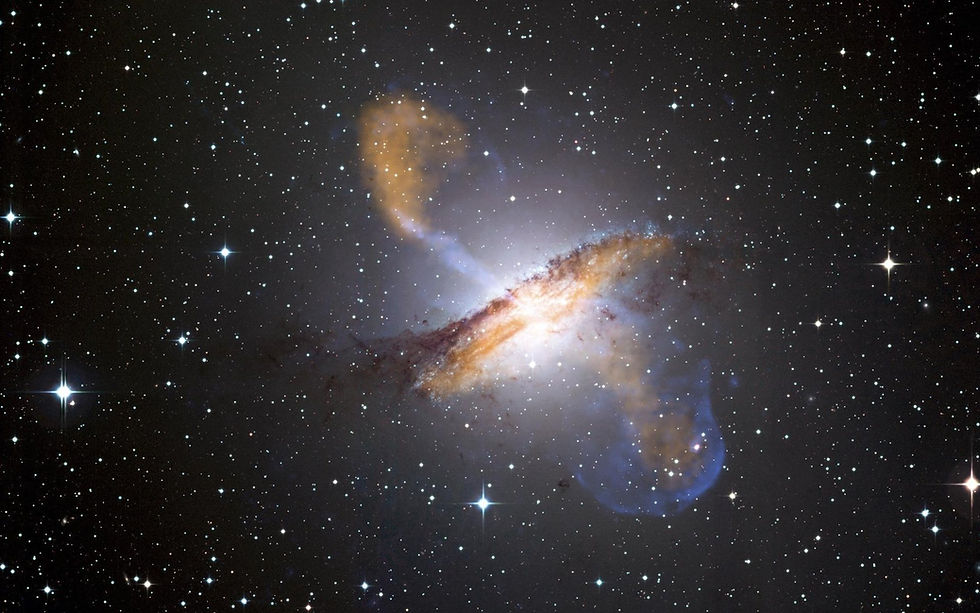Lasercom: Laser Communication in Space
- Sylvia Rose

- Mar 30
- 4 min read
Laser communication uses light to send data. It's faster and more efficient than radio waves. The amount of information transmitted is higher and it's currently used in space exploration and satellite operations.

Lasercom is essentially the same as current free-space optical (FSO) communication. It uses lasers to transmit data through space. Infrared lasers give the best speed and bandwidth.
Laser communication can transmit data at rates up to 100 times faster than traditional radio frequencies. Data is encoded by changing the properties of the laser light.
In space, laser beams are usually invisible, unless they come into contact with matter, like particles or atmospheric conditions. In this case light scatters or reflects, making it visible.

How Laser Communication Works
Encoding the Data: As with radio waves, the data is encoded into a format suitable for transmission. Encoding happens through modulation, adjusting the light to represent desired information.
Data is coded on light by modulating light intensity, frequency, phase or polarization to transmit binary data (1s and 0s) or more complex info through light pulses.
Generating the Laser Beam: A laser source, typically a solid-state laser or a fiber laser, generates a highly focused and coherent beam of light. The laser must maintain signal strength and accuracy over vast distances.

Transmitting the Beam: The laser beam is aimed and transmitted toward intended receiver. Pointing and tracking systems compensate for motion of transmitting and receiving platforms, and atmosphere disturbances.
Receiving the Beam: At the receiving end, a telescope or other optical receiver collects the laser light. The faintest of signals must be captured, as the beam spreads out a long way.
Decoding the Data: Collected light is then directed to a detector, which converts the light signal back into an electrical signal. This signal is then processed to extract the encoded data.
Atmospheric Correction: When communicating between ground stations and satellites, the laser beam passes through the Earth's atmosphere. This can cause distortions and signal loss due to atmospheric turbulence and scattering. Adaptive optics are used to correct this for better signal quality.

Advantages Over Radio Waves
The fundamental advantage of laser communication is its vastly increased bandwidth compared to radio waves. It's as if radio waves are a narrow road while laser beams are a multi-lane highway.
Higher Bandwidth
Laser beams use shorter wavelengths of light compared to radio waves. Shorter wavelengths allow for more data to be encoded and transmitted within the same timeframe, for greatly increased bandwidth.
It enables download of high-resolution images, videos and data from space observatories and probes at rates previously unimaginable. While radio frequencies carry limited data, laser systems transmit much more.
Faster Data Transfer
Laser communication supports data rates up to 10 Gbps or more. Satellite operators can send complex data faster.
Entire datasets can be downloaded in minutes instead of hours. This benefits time-sensitive needs like disaster monitoring and real-time analysis of space phenomena.

Security
Laser beams are directional, with signals concentrated in a narrow path. This makes them harder to intercept and jam.
Security is a significant concern in communication, especially in space. The focused nature makes it difficult for potential eavesdroppers to capture the signals.
Smaller Lighter Equipment
For the same data rate, lasercom tech is smaller and lighter than radio wave systems. This is an advantage for space missions, where weight and size are integral to success.
Smaller equipment leaves room for scientific instruments or increased mission capacity. Laser systems operate at higher frequencies, allowing them to send the same amount of data using less power.
Laser systems resist interference better than radio frequencies. Although they're vulnerable to atmospheric disturbances, advances in technologies like adaptive optics overcome these problems.
Laser communication can deliver high-quality data even when conditions aren't perfect. Recently, China achieves a major milestone, leaping ahead of US efforts. China successfully attains a 100 gigabit per second data transmission rate in satellite-to-ground laser communication.

Uses
Earth Observation: Downloading high-resolution images and videos from Earth observation satellites for environmental monitoring, disaster response, and resource management.
Deep Space Exploration: Transmitting data from distant probes and rovers, for more frequent and detailed scientific observations.
Inter-Satellite Links: Establishing high-speed communication links between satellites for real-time data relay and improved coordination of space assets.
In June 2021, the US Space Development Agency sends two 12U CubeSats into orbit to show off laser communication links between the satellites and a remotely operated MQ-9 Reaper.

On December 7, 2021, NASA's Laser Communications Relay Demonstration (LCRD) is launched as part of USAF STP-3 to enable communication between geosynchronous orbit and the Earth's surface.
In May 2022, TeraByte InfraRed Delivery (TBIRD) is launched on PTD-3 and tests 100 Gbit/s communications from a 300-mile orbit to California.
Laser communications in deep space are evaluated during the Psyche mission to the main-belt asteroid 16 Psyche, launched in 2023. Deep Space Optical Communications (DSOC) increases communication efficiency.
In April 2024, the test is successfully completed. The Psyche spacecraft transmits from a distance of 225 million km.
Lasercom is currently in production by various ops like the Ecuadorian Space Agency; Thales Aliana Space (French/Italian); and Surrey Satellite Technology (UK). It's in development in several other countries.

READ: Lora Ley Adventures - Germanic Mythology Fiction Series
READ: Reiker For Hire - Victorian Detective Murder Mysteries


